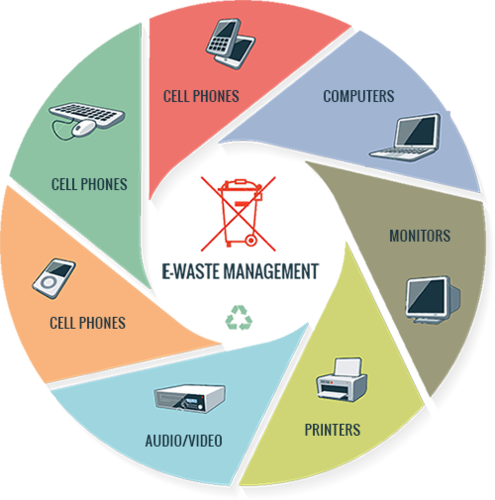What is E- Waste?

E-waste presents a serious threat to the environment, wildlife, and people. Plastics, metals, cathode ray tubes (CRTs), printed wires, circuit boards, and other materials are frequently found in e-waste. Once the e-waste is scientifically processed, precious metals like copper, silver, gold, and platinum can be recycled. It is extremely dangerous if e-waste is disassembled and processed in an imprecise manner using rudimentary techniques because it contains toxic materials like liquid crystal, lithium, mercury, nickel, selenium, polychlorinated biphenyls (PCBs), arsenic, barium, brominates flame retardants, cadmium, chrome, cobalt, copper, and lead.
When they are no longer suitable for use, electronic devices such as computers, mainframes, servers, monitors, printers, scanners, compact discs (CDs), copiers, calculators, batteries, cellular phones, fax machines, transceivers, TVs, medical equipment, iPods, refrigerators, washing machines, and air conditioners become e-waste. Even in trace amounts, heavy metals and highly toxic substances like mercury, lead, beryllium, and cadmium pose a serious danger to the environment.
Ways to Reduce and Control E-waste

Land Filling
The most typical way to dispose of electronic trash is in this way. The following stages are part of the landfilling process:
- Digging of Trenches
- E-waste being buried in holes
- Adding layers of soil to cover these pits
Incineration
Incineration is a controlled combustion procedure in which electronic waste is burned at temperatures ranging from 900 to 10,000 degrees Celsius in an incinerator unit. Hazardous substances can be changed into less dangerous chemicals or substances through incineration.
Recycling
Recycling involves the disassembly of electronic waste, which may include the disposal of many hazardous component components like printed circuit boards, plastics, CRTs, non-ferrous metal separation, mobile phones, hard drives, fax machines, wires, and memory chips.
Smaller concentrations of heavy metals and dangerous substances like lead, cadmium, mercury, and beryllium pose a serious risk to human and animal existence.
Problem Of E-Waste In India
According to the ASSOCHAM study, only computer equipment makes up roughly 70% of the total quantity of e-waste produced. Telecommunication products make up only 12%, electrical items 8%, and medical items 7%, while the remaining items come from households. Contrary to waste management standards and efforts in Europe and Japan that aim to change end-user behavior, there is no regulatory enforcement, little public awareness, and inadequate occupational safety measures for those engaged in such recycling processes.
Therefore, developing decisive strategies to practise refurbishing/recycling used e-waste in specialised facilities while focusing on environmental pollution and health risks is essential for our country.
Opportunities Of E-Waste Management In India
In order to reduce output and increase recycling, the MoEFCC developed and published the E-Waste (Management) Rules in 2016. In order to give producers the responsibility to collect 30% to 70% of the electronic waste they create within seven years, the GOI shall issue EPR with nationwide applicability.
Following such regulation, efforts have been taken to harmonise the current unorganised/informal sector
In order to enable and implement a suitable management system for e-waste handling in India, the E-waste Management Rules, 2016, were amended in March 2018.
Role Of Governments, City Administration, And Citizens In E-Waste Mitigation
The GOI needs to work with the industry to develop some standard operating procedures and a planned phased strategy while emphasising the agency’s goal of reducing e-wastes to the absolute minimum amount, according to the ASSOCHAM report[1].
In addition, the GOI should encourage concepts used by developed countries to implement an efficient system of accumulation and recycling. The GOI must provide financial assistance, tax exemptions, and technical mentoring to companies in order to encourage the establishment of waste recycling and disposal facilities.
The GOI should take the initiative to serve as a mentor and collaborator in order to render and calibrate the reciprocal coordination between the jumbled, disorganised recycling sector.